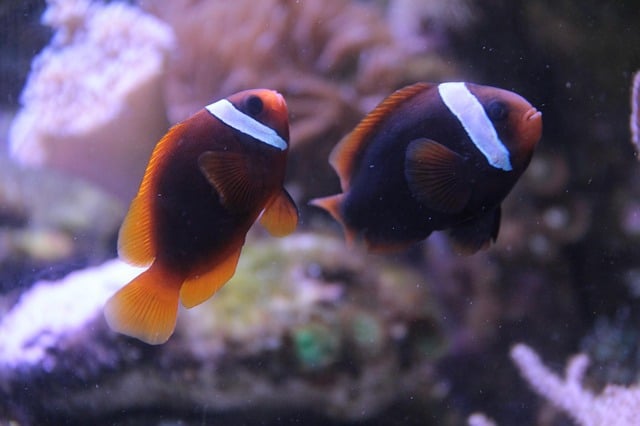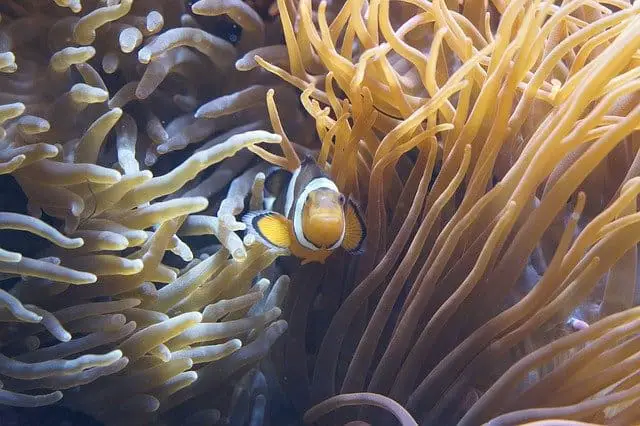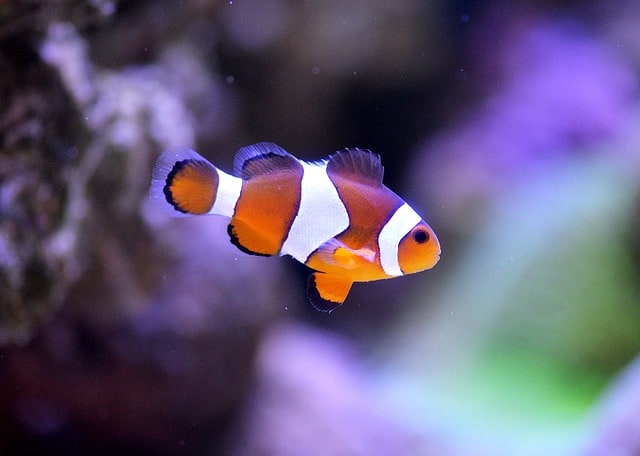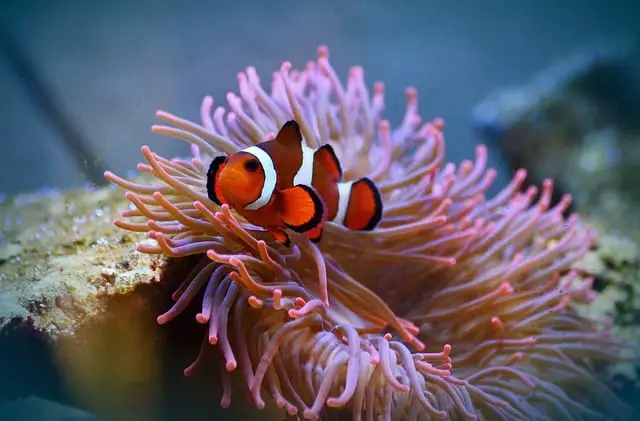When you think of clownfish, the first thing that often comes to mind is the peaceful and timid ‘Nemo’ from Disney’s famous animated movie entitled Finding Nemo. However, in real-life, clownfish are quite different. They’re often aggressive and territorial in nature, which can be problematic when it comes to keeping them in a saltwater tank with other fish. Do they attack other fish? Well, the answer is:
When clownfish are confined to a small space, they can become aggressive. They will often attack other, smaller fish that invade their territory. The only way to keep multiple clowns with other fish in the same aquarium is to add them all at once when they’re still young. Some species of clownfish are more aggressive than others and should only be kept in very large tanks of 100-gallons or more!
Now that you know clownfish can and do attack other fish in a confined aquarium environment, let’s take a closer look at this further and in more detail. I’ll discuss if, in fact, clownfish can kill other fish and what it is that makes them so aggressive. I’ll also explain which types of fish can be kept with clowns and whether (or not) anemones help curb their aggression.
So, if you’re ready to learn more about clownfish and their aggressive behaviours in a captive environment, then let’s get started…
Do Clownfish Kill Other Fish?
While it’s not that common for a clownfish to kill another of its species, it will become aggressive if not given enough food or if confined to too small of a space in an aquarium. Both circumstances will cause the fish to ‘compete’ with each other– often in a reckless manner that can result in injury, and possibly death, to one or more of the fish.
During breeding times, clownfish can also become extremely aggressive. Males that are forced to compete for the attention of a lone female, for example, will fight – even to the death! Therefore, it’s best to keep them in pairs (one male with one female) and only a single pair to a tank. Never introduce multiple breeding pairs as this will only spur their naturally aggressive tendencies.
Why is My Clownfish so Aggressive?
In order to better understand clownfish aggression, you need to be aware of how they live in their natural habitat. Wild-caught clowns that are used to defending their territory in the shallow waters of the ocean, won’t hesitate to attack other fish that invade their space. As well, female clowns have been known to drive off or even attack and kill their current mates in pursuit of a new partner.
If you’ve recently introduced new fish to the aquarium, you may notice some aggressive tendencies in your otherwise ‘peaceful’ clownfish. Such changes to their aquatic environment will be stressful for the fish and they’ll react by chasing, nipping or even fighting with the other creatures in the tank.
Some species of clownfish are more aggressive than others. These include maroons, saddlebacks, fire, and tomato clowns. They’ll even ‘bite the hand that feeds them’ – meaning they’ll draw blood if you happen to put your arm inside the tank! In fact, many aquarium hobbyists opt not to keep them at all based solely on their hostile and territorial nature.
Are Orange Clownfish Aggressive?
Orange or true percula clownfish as the smallest of their species and highly sought-after by many saltwater aquarium hobbyists. However, don’t let their small size fool you. What they lack in stature, they more than make up for in personality!
Unlike other clownfish, the true percula is semi-aggressive in nature and can do quite well in a reef-like set-up in a aquarium that holds (at the very least) 5 gallons of water – 10 to 20 gallons is better. If you keep orange clownfish with an anemone, they’re likely to remain peaceful, even with other fish of a different species in a community tank.

Can I Keep 2 Clownfish in a 10-Gallon Tank?
No matter what size saltwater tank you have, you should only ever keep two clownfish at a time – preferably one male and one female. If you keep more, two will eventually pair up and harass or possibly kill the other clownfish in the aquarium.
If you choose to keep two males or two females to prevent breeding, be sure they’ve been ‘raised’ together from a young age. Even this may not stop their innate ability to reproduce rapidly. It’s been reported that if two males are kept together in the same tank, one may spontaneously change sex!

Do Anemones Reduce Aggression in Clownfish?
For some species of clownfish (like the orange or true percula), having an anemone in the tank will significantly reduce aggression, though it likely won’t eliminate it completely. An anemone provides a sense of security for clownfish, which lessens stress that can cause hostility towards other creatures in the aquarium. It provides the clown with a ‘home’ in which to retreat for safety or comfort.
Unfortunately, just as clownfish have the ability to kill other fish, so too can they kill an anemone – albeit unintentionally. If the anemone is too small for the clown, it will die from stress. Adding an additional anemone to the tank is helpful, as the fish will likely split its time between the two. To keep anemones healthy, consider feeding them once a week with a protein-rich food such as brine shrimp.
How Do You Stop Clownfish from Attacking Other Fish?
To stop clownfish from attacking other fish in aquarium, consider the following:
- Introduce the largest fish last.
- Introduce new fish at night so they have time to adjust to their new surroundings before meeting their fellow tankmates.
- Add an anemone, such as the carpet anemone or the saddle anemone.
- Provide plenty of hiding places reminiscent of a reef environment such as seagrasses, sand, and live rock.
- Keep only two clownfish in a tank, regardless of the size of the aquarium.
- Don’t keep clownfish in anything smaller than a 10-gallon tank – ‘bigger is better’ when it comes to saltwater aquariums.
- Limit the lighting in the tank to 8 or 10 hours only – clownfish are often more aggressive in bright light.

What Fish Can be Kept with Clownfish?
When considering possible tankmates for your clownfish, keep in mind both the size of the fish and the tank itself. Don’t add any smaller fish after the clown has established itself in the aquarium. If you do decide to introduce more fish, make sure they’re bigger than the clown and do so at night. Keep in mind the rule-of-thumb when it comes to stocking a saltwater tank – ½ inch of fish per every gallon of water.
Ideal tankmates for smaller, less aggressive clownfish (like the true percula) include:
- anemones
- angelfish
- blennies
- cleaner shrimp
- chromis damselfish
- gobies
- mandarin dragonets
- soft or hard corals
- tangs
- wrasses
It’s important to note that harmony in a saltwater tank is dependent upon each fish having ample space to swim and explore freely. Overcrowding an aquarium will not only lead to heightened aggression, but it’ll also affect the overall health of its inhabitants. Therefore, always remember that ‘bigger is better’ when it comes to successfully maintaining a saltwater aquarium.
Conclusion
To conclude, clownfish can become aggressive when confined to a small space, such as that of a saltwater aquarium holding less than 20-gallons of water. Any fish that invades their territory is often met with fierce hostility.
Clowns will chase, nip, or even attack and kill other smaller fish in a community tank. Therefore, it’s best to keep just two in a tank, if possible. The only way to keep multiple clownfish in the same aquarium is to add them all at once while they’re still juveniles.
Hopefully, you’ve found this article to be both interesting and informative. Thanks for reading and good luck with your saltwater aquarium.
Related Posts
What Saltwater Fish Can Live in a 5-Gallon Tank
Do Guppies Need Other Guppies?
Why Do Clownfish and Sea Anemones Pair Up?




